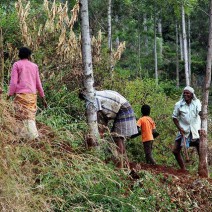Forest Restoration Gets A Tiny Fraction Of The Money It Needs. How To Fill The Gap?
Despite plenty of political momentum for forest restoration, only about 17% of funding needs are met each year with very little of that coming from the private sector. However the World Resources Institute and partners have crafted a plan to scale restoration so it delivers environmental and financial returns which should entice larger private investments.

Originally posted on the World Resources Institute Blog.
8 September 2016 | Support for restoring the world’s deforested and degraded landscapes is growing rapidly.
A 2014 report by the New Climate Economy noted that restoring just 12 percent of degraded agricultural land in the world could feed an additional 200 million people by 2030, while providing environmental benefits. Thirty-one countries have made commitments through the Bonn Challenge, a global initiative to restore 150 million hectares of degraded land by 2020 and 350 million hectares by 2030. And new regional restoration initiatives have emerged in Africa and Latin America and the Caribbean.
So with all this political momentum, where’s the money?
Research shows that only 13-17 percent of the total annual funding needs for restoration and conservation are met—about $50 billion. That means there is a shortfall of $250-350 billion per year. Of the money available, most comes from government or philanthropic sources, with only $10 billion per year invested by the private sector.

Addressing this financing gap with both private and public funds is key to expanding restoration on a global scale. However, the private sector is usually interested in a return on investment, which has been difficult to enumerate since the costs of restoration are more easily measured than the benefits. Also, investment capital needs to align with the longer time-frame of restoration projects, and business models and policies must be conducive to large-scale restoration.
This is where the New Restoration Economy (NRE) comes in.
With support from the Doris Duke Charitable Foundation and in partnership with The Nature Conservancy, WRI aims to scale restoration to deliver environmental and financial returns. Scaling up restoration finance will require tackling it from three angles:
Business
What business models will enable restoration to pay for itself? We’re exploring case studies in Brazil, Kenya and the United States; investigating innovations that can be replicated in different geographies; and working with entrepreneurs and companies.
Komaza is one example. Based in Kenya, the company is pioneering an approach known as “microforestry” by working with smallholder farmers to plant eucalyptus and melia volkensii trees on their land. Komaza purchases the trees and manages the value chain from nursery to harvest. By purchasing trees from thousands of smallholder farmers near the major port of Mombasa, Komaza is able to build the supply of a plantation while bypassing the traditional plantation model, which often requires large areas of land and has high transport costs.
Finance
How do we spur private investment in restoration? We are addressing this issue on multiple fronts: understanding what private investors want; broadening the range of investors interested in restoration; connecting restoration enterprises to capital; and identifying how public finance can better leverage the private sector.
There is a funding chasm between small grant providers who write checks of $200,000 and institutional investors who may be interested only in ideas that are $200 million and up. So, as we mobilize capital for restoration, we’ll need to engage investors like Althelia. With $120 million slated for investment in restoration projects through Initiative 20×20—a program to restore more than 20 million hectares of degraded land in Latin America by 2020—Althelia is accelerating the pace of restoration, generating impact while producing an investment return.
Policy
How can policy get restoration moving on the ground? Well-designed policies are essential to create an enabling environment for restoration investments. We aim to identify and develop effective policies that can unlock barriers to scale and incentivize investments from the private sector.
China’s Loess Plateau is a prime instance of how restoration policy has a dramatic impact. In the 1980s and 1990s, deforestation and unrestricted grazing led to rapid soil degradation and sandstorms in the country. By the 2000s, however, bans on these activities—coupled with intensive reforestation programs—had transformed the once barren landscape into lush plains.

What we need is a paradigm shift in restoration, proving its value for investors and environmentalists alike. Ultimately, we hope the New Restoration Economy will help to usher in the greener, cleaner world that we are all eager to see.
Sofia Faruqi is the Manager of the World Resources Institute’s Global Restoration Initiative. She can be reached at [email protected].
Please see our Reprint Guidelines for details on republishing our articles.

